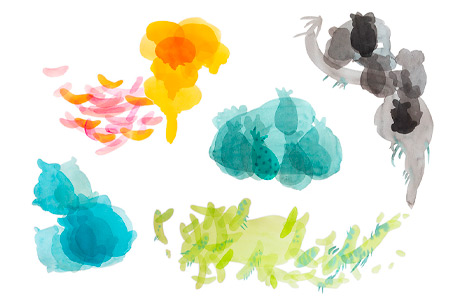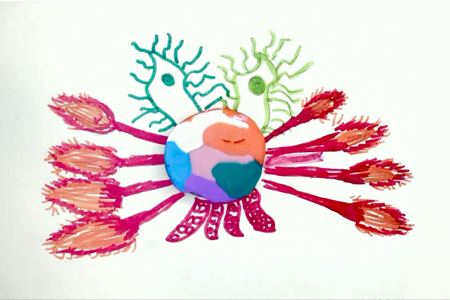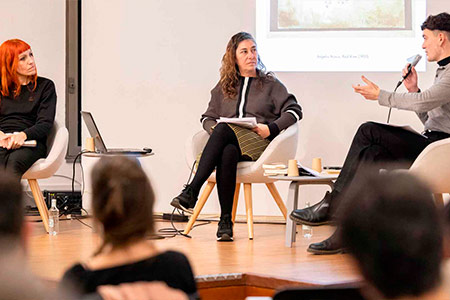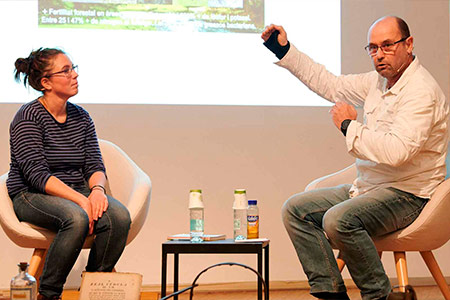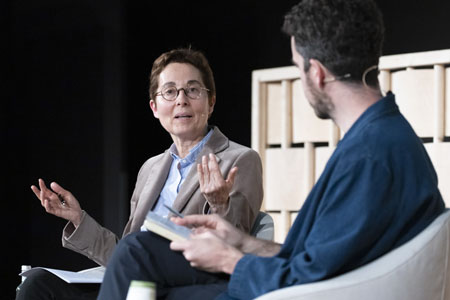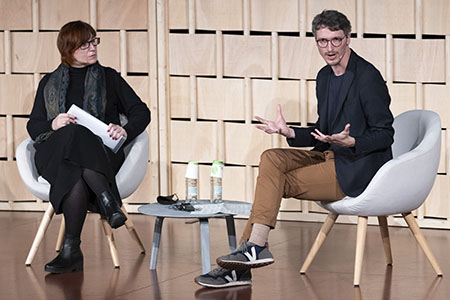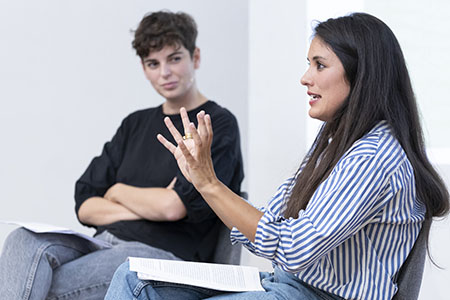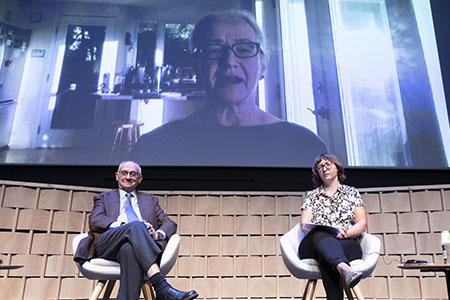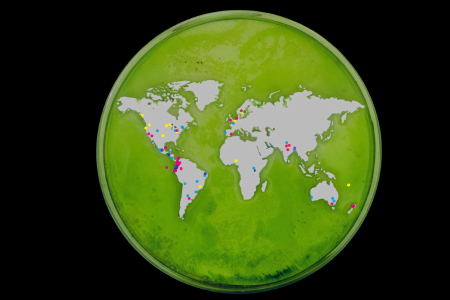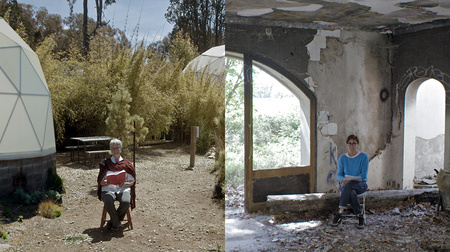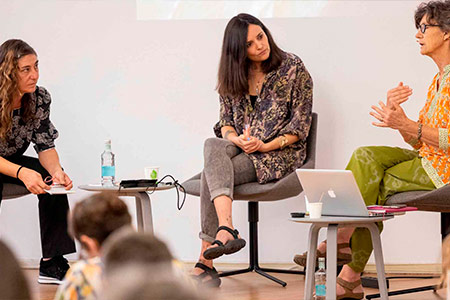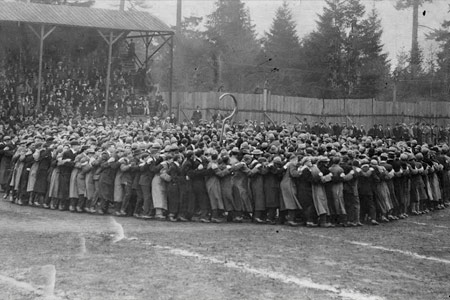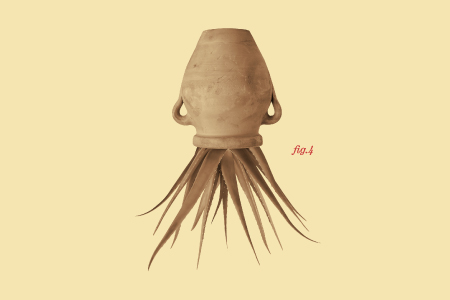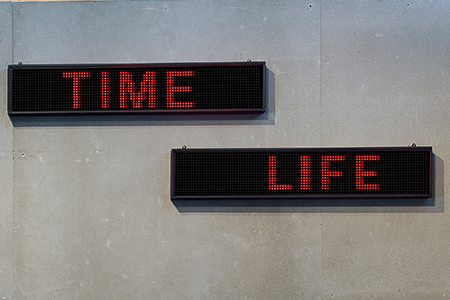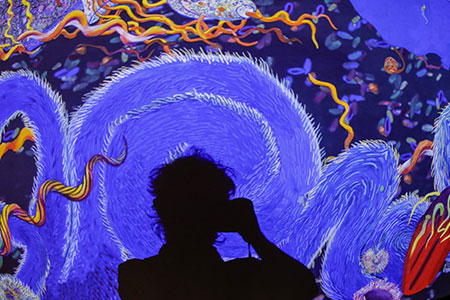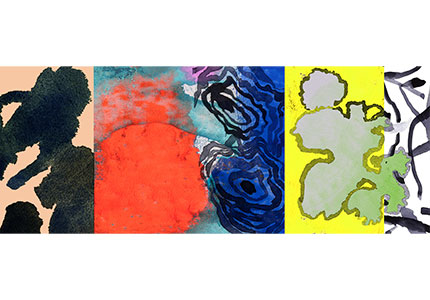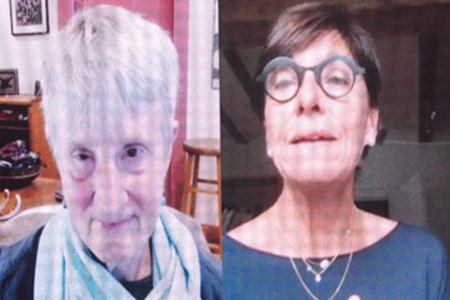Science Friction
Living Among Companion Species
Is it possible to imagine other earthly stories? Can we conceive of other ways of living among different species? This exhibition explores these issues with the help of a selection of works of art and popular science. It proposes a change of mentality and sensitivity that questions the supremacy of the human species, opting for a view of the world understood as an ecosystem where all the planet’s species coexist.
"Endosymbiosis. Homage to Lynn Margulis" (2012), Shoshanah Dubiner, animation by David Domingo
In her theory on endosymbiosis, published in 1967, Lynn Margulis states that eukaryotes (cells with a nucleus), from which all plants, fungi and animals descend, emerged from the symbiotic fusion of primitive bacteria (prokaryotic organisms with cells without a nucleus). With this theory, Margulis ...
Are Viruses Alive?
Serafín Álvarez | Roc Jiménez de Cisneros
A conversation between two artists to explore the limits of language and the taxonomies of life.
Bioscopi 2021
An animated collective bestiary
How would microscopic, medium and giant beings, be able to live on planet Earth or in extreme conditions like those on planet Mars? Bioscopi: Imaginary Creatures proposed three animation exercises in the field of speculative zoology, using imagination and cinematic techniques such as stop-motion or artificial intelligence.
Frictions in Reality
Elisabet Roselló
A reflection on the meaning of what is plausible in times of climate change and technological acceleration.
How to avoid temporalities of progress?
Pol Guasch and Laura Benítez
We talk with independent curator and philosopher Laura Benítez and researcher and writer Pol Guasch about how to conceive different temporalities – human and non-human –, what worlds each temporality generates and how narrative arts allow us to generate stories ...
Is it possible to build shelters in a damaged planet?
Cristina de Llanos Santaulària and Ignasi Castellví
We talk about co-existence and competition between humans and non-humans, the ruralisation of forests and regeneration practices, and the rebalancing of the ecosystems: how can we regenerate refuges? How can we contribute to the rebalancing of ecosystems? How can we practise a cooperative co-existence ...
Which myths are needed?
Mafe Moscoso and Ma Antònia Martí Escayol
We talk with anthropologist, independent researcher and migrant Mafe Moscoso and environmental historian and science-fiction writer Maria Antònia Martí Escayol about other myths narrated with the mixed languages of art, history and speculative fabulation: how long, ...
Marta Segarra and Gerard Ortín
Humanimal Encounters
Marta Segarra talks about language as a supposed border between human and non-human animals and dialogues with the artist Gerard Ortín about the fascination caused by its hybridization and how it manifests itself in the arts and sciences.
Pierre Charbonnier and Ester Jordana
An Ecological Transformation of Ideas
The philosopher Pierre Charbonnier talks about how political thinking has been based on an extractivist view of nature , and he dialogues with professor Ester Jordana about a new ecology of political ideas.
How to escape from human exceptionalism?
Toni Navarro and Óscar Martín
W converse with independent researcher, artist and programmer Óscar Martín and philosopher Toni Navarro about the networks of biochemical consciousness, non-human intelligence, responsibility and technologies of terraformation: what responsibilities must we ...
Estelle Zhong Mengual and Mariona Moncunill
Learning to See
The art historian Estelle Zhong Mengual speaks about how the living world is omnipresent in our culture and yet absolutely absent from it and, with the artist aMariona Moncunill, discusses the fact that perceiving it as a decoration, a symbol, or support for our emotions are ways of not seeing it.
Margaret McFall-Ngai, Ricard Guerrero and Carme Puche
The Legacy of Lynn Margulis
Ten years after the death of biologyst Lynn Margulis, we talk about what advances have been made in the study of symbiosis and what questions remain to be answered about the origin of life and the symbiotic relationships among organisms.
Is it possible to imagine a non-apocalyptic future?
Julia Ramírez-Blanco and Cuchara collective
We converse with researcher and historian Julia Ramírez-Blanco and with activists from the food emancipation initiative Cuchara, to delve deeper into the challenges of projects that combine activism, art and science, speculative fables that materialise into stories without ...
The Movement for the Rights of Nature (2021), Jaime Serra
The movement for the rights of nature – whose origins can be traced back, at least, to the middle of the 20th century – has gained momentum over the last decade, particularly since the approval of the Constitution of Ecuador in 2008: the first legal text to take a biocentric approach and recognise non-human life forms as legal subjects.
"Camille & Ulysse", by Diana Toucedo
The philosophers Vinciane Despret and Donna Haraway join their voices in two fables that each of them had previously written: “The Camille Stories” in Staying with the Trouble: Making Kin in the Chthulucene, 2016 and Autobiographie d’un poulpe, Actes Sud, 2021. These stories raise the question about how we live together with absences, the effect on an assemblage of species when the fragments it is made up of disappear, and how we can expand our spectrum of thought to House interspecies relatinoships within it. ...
How to make kin with the other species?
Clara Piazuelo and Eloïsa Matheu
We talk about co-domestication, zoonosis, compost, collaborations between species and responsibility with investigator Clara Piazuelo and biologist and sound landscaper Eloïsa Matheu: how do we let non-human beings affect us? How can we practise curiosity without sadism to ...
The Limits of a World in Relation
Ignasi Torrent
A critical reflection on the limits of the conception of an interconnected cosmos in the Anthropocene era.
Thinking Like an Octopus
Maria Ptqk
Several artists in the "Science Friction" exhibition tell us about their relationship with scientific knowledge and how they incorporate it into their creative strategies. Their voices, alongside other reference points in the exhibition, open up possible paths on the long journey of interaction ...
Time-Life-Time (2021), Jaime Serra
Installation
The installation Time-Life-Time by the artist Jaime Serra, produced by the CCCB for “Science Friction” exhibition, brings a historical perspective to the rise of biocentric thinking throughout the 20th century with a selection of key works, people, organizations and events. © ...
Maria Ptqk: "Science Friction is between the art exibhition and a science museum"
Curator Maria Ptqk presents the creative, artistic universe of the exhibition “Science Friction”, a journey through works of art and science that proposes a change of mentality and sensitivity in inter-species relationships. With “Science Friction”, you’ll discover ...
Lichen
Maria Arnal, María Sánchez, Irene Solà
A story of fish and nature, of drought and reservoirs, of stones and voices, based on the words of Donna Haraway.
Donna Haraway and Vinciane Despret
Companion Species
Philosophers Donna Haraway and Vinciane Despret will speak about how to construct stories that weave new alliances between humans and the rest of the living species in a planet headed for an uncertain future.

